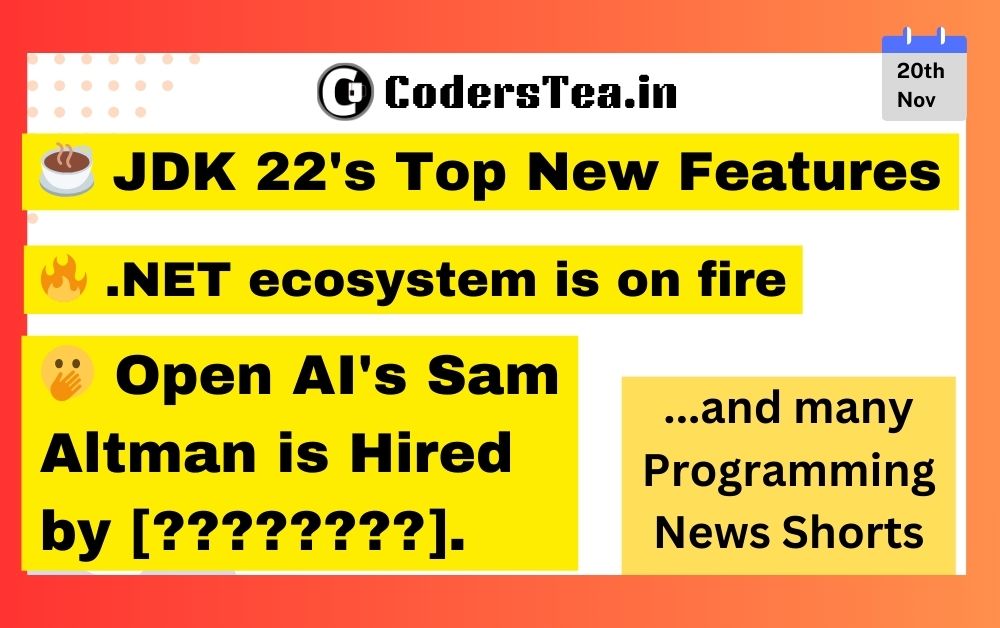
C#, Java, Open AI on The Programming News Shorts, 20th Nov
“Hello Devs”! Here are the top Programming news shorts for you. ☕️ JDK 22’s Top New Features 🔥 .NET ecosystem is on fire 🪟 Open AI’s Sam Altman Hired by [???] And much more in today’s Programming News Shorts Stories. Previous Stories: Programming News Shorts, 29th Oct Developer’s News Shorts for 19th Oct C# vs Java, Gen AI for Website, AWS DataZone, and Much more – Dev news, 13th Oct ☁️ Cloud and You 🐘 Dynamic PostgreSQL, an Alternative to Serverless Databases Timescale recently introduced Dynamic PostgreSQL, a new cloud-managed option to scale the database capacity within a predefined vCPU range. Promoted as “buy the base and rent the peak”, the new option scales the capacity according to the load, trying to address the unpredictability and variability of serverless options. ...
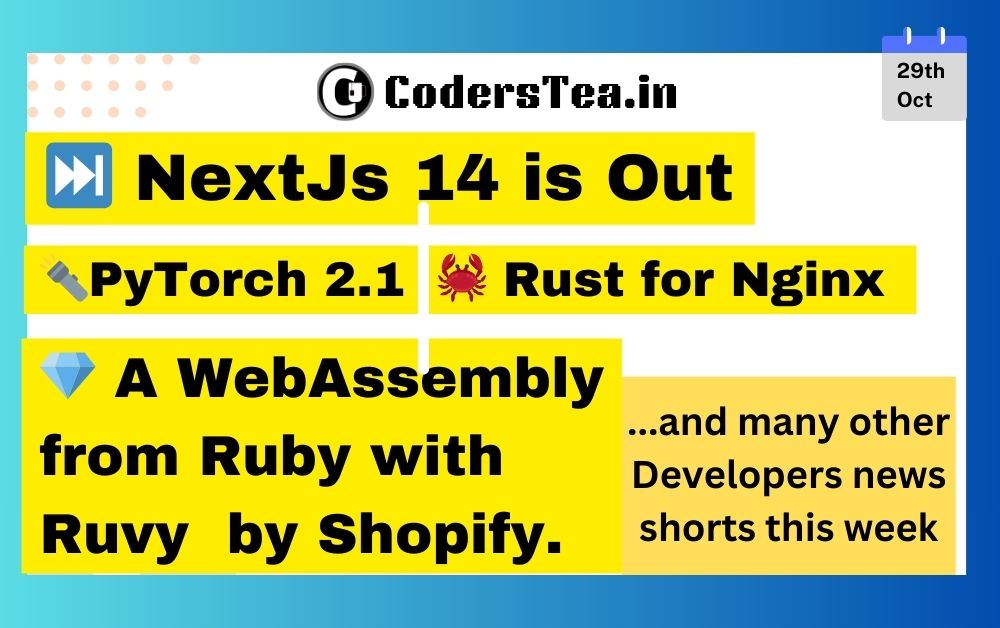
Programming News Shorts, 29th Oct
“Hello Devs”! Here are the top Programming news shorts for you. ⏭️ NextJs 14 is Out 💎 A WebAssembly from Ruby with Ruvy 🔦 PyTorch 2.1 🦀 Go The Rust Way for Nginx Module 📊 Delivery Metric to the Notification by Apple 🍎 and Much more in today’s Programming News Shorts Stories. Previous Stories: Developer’s News Shorts for 19th Oct C# vs Java, Gen AI for Website, AWS DataZone, and Much more – Dev news, 13th Oct Java 21 by Microsoft, Typescript new Version and Much more – Dev news, 6th Oct 💪 Work with Framework ⏭️ NextJs 14 is Out Vercel, the team behind NextJs a Popular React Framework has announced the latest version 14. This version has few updates including an update to Turbopack, which offers 53% faster local server startup and 94% faster code updates with Fast Refresh. ...

Developer's News Shorts for 19th Oct
“Hello Devs”! Here are the top developer’s news shorts for you. 🔥 New Node.js 21 is lit 📜 JetBrain’s new Document IDE?🤔 🥵 Hot Reload is Now Easier in Docker Compose 💻 Ubuntu Desktop 23.10 is here 🔥 And much more in today’s short news shorts for developers. Previous Stories: C# vs Java, Gen AI for Website, AWS DataZone, and Much more – Dev news, 13th Oct Java 21 by Microsoft, Typescript new Version and Much more – Dev news, 6th Oct Python New Version and Other Developer News Summaries, 3rd Oct 💪 Work with Framework 🔥 Node.js 21 is now available! The Node.js Project Team has announced the release of Node.Js 21. Highlights include updates of the V8 JavaScript engine to 11.8, stable fetch and WebStreams, a new experimental flag to flip module defaults (–experimental-default-type), a built-in WebSocket client, many updates to our test runner, and more! ...

Easily Calculate Memory From Bytes to KB, MB, GB, TB
Here is the list with numbers of bytes for each size. With this, you can quickly identify which size metric to show instead of saying a number of bytes. Very helpful for your next System Design Interview. 1 Byte = 8 bit. For simplicity, I am using 1000 as the base instead of 1024 for KB and further calculations. You can mention this to the interviewer to make them aware. ...
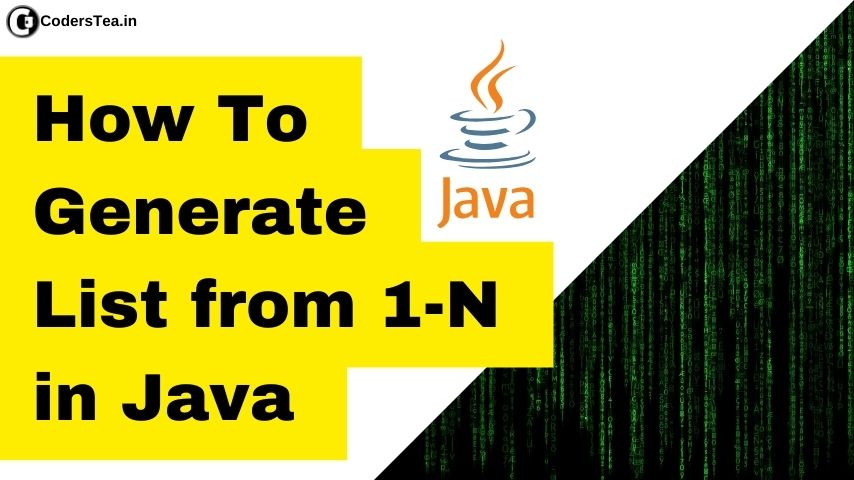
How to Generate List from 1 to N in Java
There are multiple ways to generate the list from 1 to N or M to N in Java. We will look at 3 with various versions of Java. Using Simple For Loop Just iterate from 1 to N in for a loop and add it to the list. int n = 10; List<Integer> list = new ArrayList<>(n); // 1 to n (inclusive) for (int i = 1; i <= n; i++) { list.add(i); } Using IntStream - Java 8 Using IntStream’s range for end exclusive and rangeClosed for end inclusive. Here is how. ...
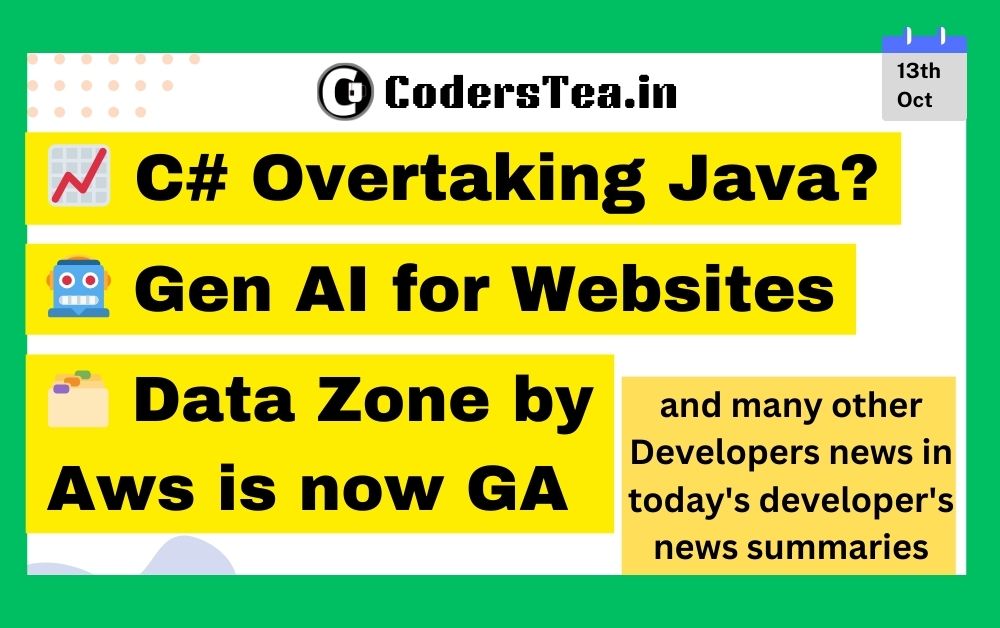
C# vs Java, Gen AI for Website, AWS DataZone, and Much more - Dev news, 13th Oct
“Hello Devs”! Here are the top developer’s news summaries for you. 📈 C# Overtaking Java? 🔥 Android 14 is here. 🤖 Gen AI for Website in Vercel 🗂️ Data Zone by Aws and New Build tools for Java And much more in today’s short news summaries for developers. Previous Stories: Java 21 by Microsoft, Typescript new Version and Much more – Dev news, 6th Oct Python New Version and Other Developer News Summaries, 3rd Oct Byte Sized Developer News Summaries, 29th Sep 🤝 United by Programming 📈 Java vs C# Popularity, Who is Winning? Microsoft’s C# language is creeping up on Java in the Tiobe index of language popularity, a trend that could see C# surpassing Java soon. ...
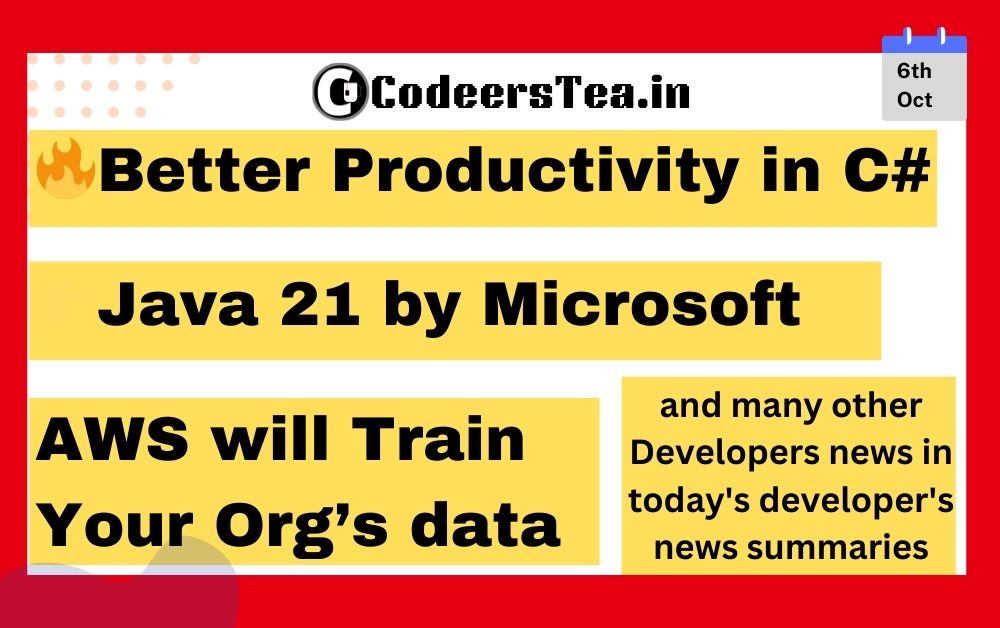
Java 21 by Microsoft, Typescript new Version and Much more - Dev news, 6th Oct
“Hello Devs”! Here are the top developer’s news summaries for you. 🔥 Better Productivity in C# VS Code Dev 👉 Java 21 by Microsoft 👉 Typescripts this version is in Beta 🤖 AWS will Train Your organization’s data And much more in today’s short news summaries for developers. Previous Stories: Python New Version and Other Developer News Summaries, 3rd Oct Byte Sized Developer News Summaries, 29th Sep High Performant Serverless Java with GraalOS – Dev News, 26th Sep 💪 Work with Framework 🔥 C# Development in VS Code is Skyrocketing due to this New Plugin Microsoft has announced the General Availability of C# Dev Kit, a Visual Studio Code extension that improves editor-first C# development experience to Linux, macOS, and Windows. ...
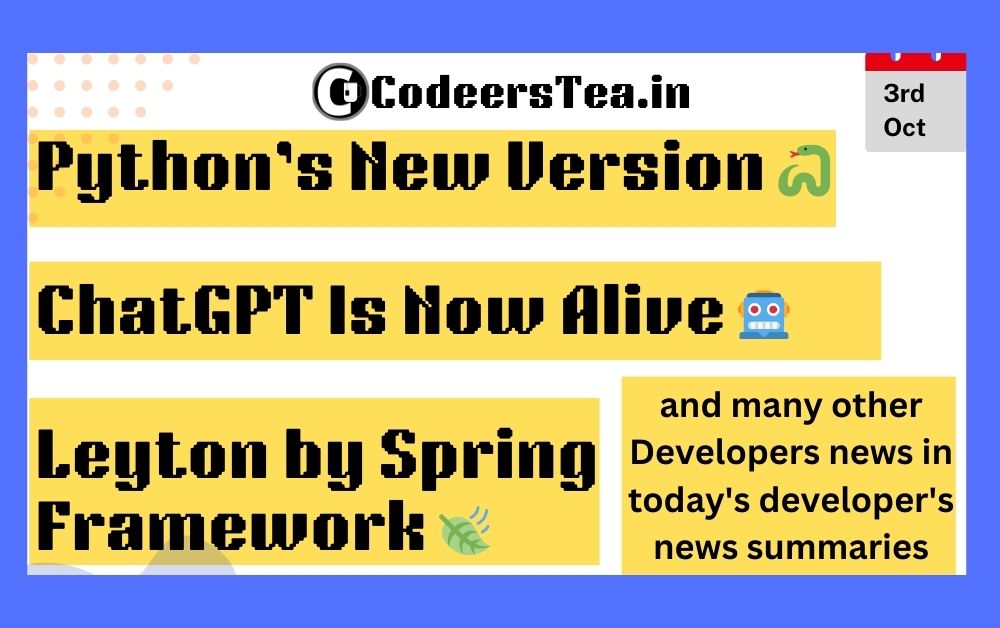
Python New Version and Other Developer News Summaries, 3rd Oct
“Hello Devs”! Here are the top developer’s news summaries for you. The new version of Python was released 🐍. ChatGPT can respond to Images and Audio 🤖. Leyton by Spring Framework. New PostgreSQL support from Microsoft Azure. And many more news summaries for developers. Previous Stories: Byte Sized Developer News Summaries, 29th Sep High Performant Serverless Java with GraalOS – Dev News, 26th Sep Tech News Summaries for Developers, 22 August 💪 Work with Framework 🍃 Leyton, The Spring Cloud 2023 The Spring Team has released the second milestone M2 of the Spring Cloud 2023.0.0, codenamed Leyton. The version is officially called 2023.0.0-M2. ...
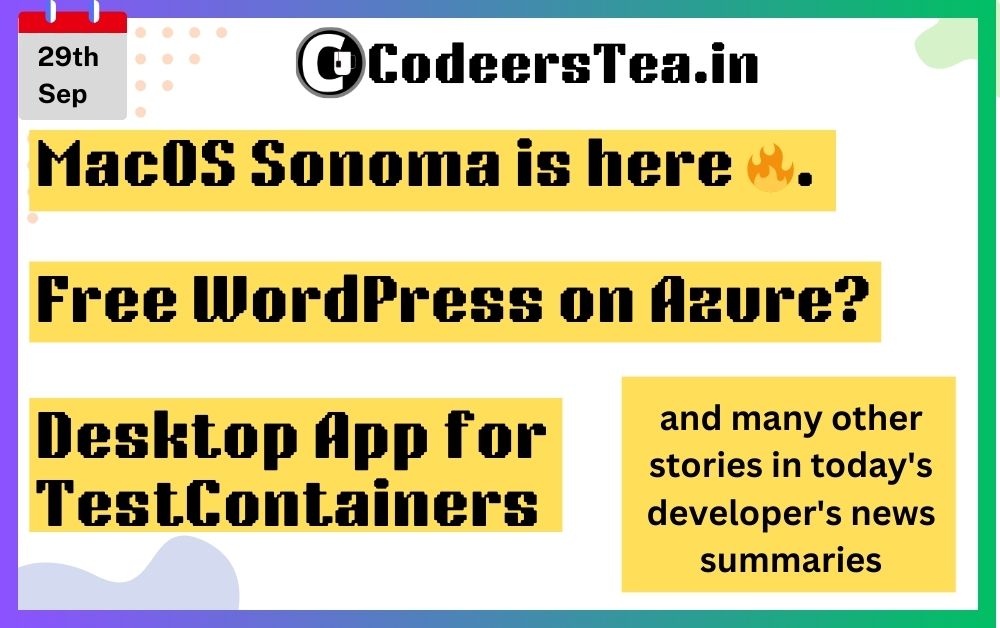
Byte Sized Developer News Summaries, 29th Sep
“Hello Devs”! Here are the top developer’s news summaries for you. MacOS Sonoma is here 🔥. Free WordPress on Azure? Desktop App from TestContainers, Rustrover, SurrealDB, and much more exciting news for developers today. Previous Stories: High Performant Serverless Java with GraalOS – Dev News, 26th Sep Tech News Summaries for Developers, 22 August 16th PostgreSQL, Train AI on your Org’s Data- Developer News, 19th Sep ☁️ Cloud and You 🆓 Free WordPress on Azure? One year after introducing WordPress on Azure App Service, Microsoft has started offering a free hosting tier for developers to explore with WordPress on Azure without incurring any costs (almost). ...
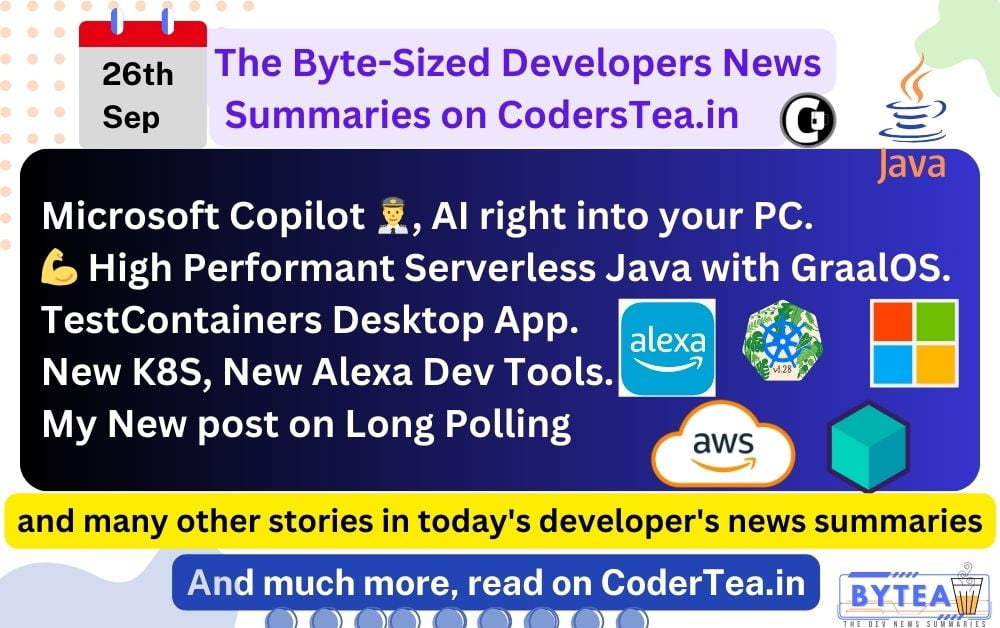
High Performant Serverless Java with GraalOS - Dev News, 26th Sep
“Hello Devs”! Here are the top developer’s news summaries for you. Microsoft Copilot 👨✈️, AI right into your PC. 💪 High Performant Serverless Java with GraalOS. TestContainers Desktop App. My New post on Long Polling, and much more in today’s developer news summaries. Previous Stories: Java 21 with Lots of New Features, Developer News, 21 Sep ☁️ Cloud and You 🅾️ GraalOS, A Java Serverless by Oracle Oracle announced GraalOS, a high-performance Serverless based on GraalVM to deploy Java-based Applications. It offers a lot of performance thanks to it being able to run natively on Linux. ...